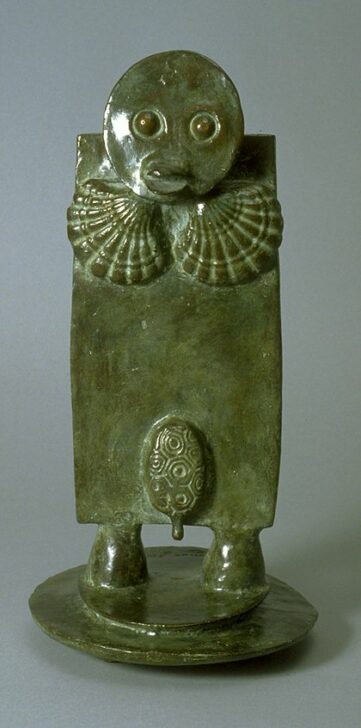Janus Bird (Oiseau Janus)
Max Ernst

Description
After Ernst arrived in the United States, he eventually settled in Arizona with his second wife, the artist Dorothea Tanning. Ernst was extremely well-read, and expressed a great interest in the art of other cultures—Africa, Oceania, and Native America. Janus Bird incorporates some of the artist’s fascination with the totemic emblems of other cultures, such as the turtle and frog. The name of this work is derived from the Roman god Janus; although the sculpture is double-faced, its duality has to do with sexual identity rather than Roman tradition. The frog and turtle become genitalia on this figure composed of discrete elements combined in an additive manner.
Ernst’s fascination with birds dates back to a particularly memorable childhood experience. A beloved pet bird died on the same day as the birth of Ernst’s sister, and these two incidents remained linked in a mysterious connection in the artist’s mind. Scholars have also described his bird-creation Loplop as an alter ego of the artist. The portentous bird association seems to resonate in the Janus Bird. Here the whimsical elements are combined to create a work full of mysterious life.
Label copy from exhibition "Dreamscapes: The Surrealist Impulse," August 22 - October 25, 1998
Subject Matter:
This figurine with its primitivist style and use of animal iconography suggests a ritual totemic figure. One side represents man. The other side represents woman. Title references the Roman god Janus the god of doorways, and thus of beginnings and endings, or of the point in time between past and future. Janus was depicted as having two faces, so he could look simultaneously forward and backward
Physical Description:
Standing bronze figure with recto/verso. The silhouette of the body is rectangular in shape. The heads on both side are simply rendered with rounded eyes and a pursed -lip mouth on one, a button nose on the other; bodies are supported by short legs; sides loosely suggest representations of male and female anatomy with side-by-side scallop shells suggesting a breasted chest on one side, an upward facing frog/toad in the phallus area on the reverse side.
Usage Rights:
If you are interested in using an image for a publication, please visit https://umma.umich.edu/request-image/ for more information and to fill out the online Image Rights and Reproductions Request Form.